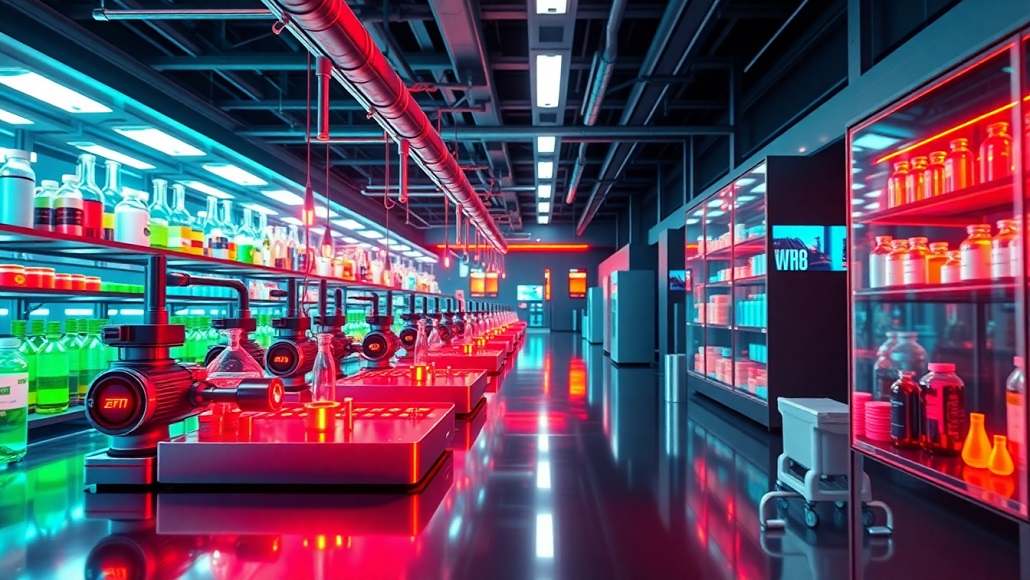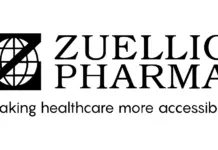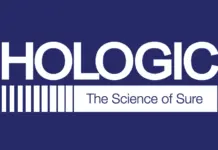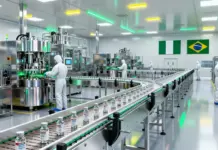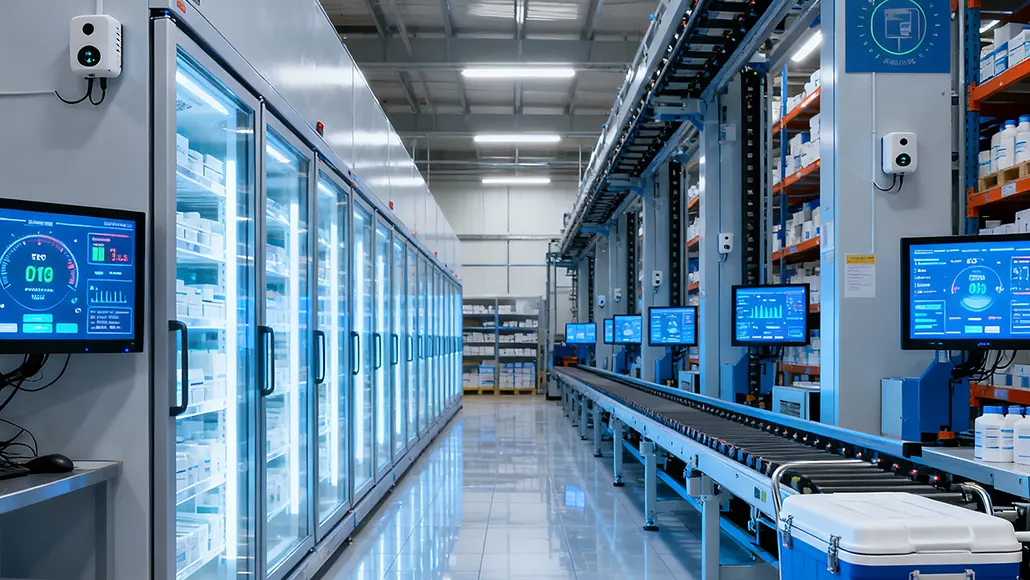From Lab to Market: Building Regional Biotech Supply Chains
The transformation of a promising therapeutic discovery into a medicine available to patients requires navigating one of the most complex supply chains in any industry. For biotech companies operating in the Middle East, building resilient and localized supply chains has evolved from a strategic advantage into an operational imperative. The region’s pharmaceutical market, valued at approximately USD 57 billion in 2025 and projected to reach USD 78 billion by 2033, reflects not merely growing demand but a fundamental shift toward self-sufficiency in pharmaceutical production and distribution. This evolution represents a decisive move away from historical dependence on imported medicines toward establishing comprehensive biotech supply chains that span from raw material sourcing through manufacturing, distribution, and delivery to patients.
The global pharmaceutical logistics market provides context for understanding the scale and complexity of biotech supply chains. Estimated at USD 99.33 billion in 2024 and projected to reach USD 208.26 billion by 2033, the pharmaceutical logistics sector encompasses the specialized transportation, warehousing, and distribution systems required to maintain drug quality and efficacy throughout the supply chain. Within this broader landscape, biopharmaceutical logistics face unique challenges stemming from the temperature-sensitive nature of biologics, cell therapies, and other advanced therapeutic modalities that increasingly dominate innovation pipelines. The Middle East’s strategic positioning between European, Asian, and African markets creates both opportunities and obligations for developing supply chain capabilities that serve not only regional needs but also enable the area to function as a pharmaceutical hub for surrounding regions.
The Imperative of Supply Chain Resilience
Recent global events have starkly illustrated the vulnerabilities inherent in pharmaceutical supply chains characterized by geographic concentration and limited redundancy. The COVID-19 pandemic exposed critical weaknesses as disruptions in one region cascaded globally, causing shortages of essential medicines and medical products that threatened public health. These experiences accelerated industry recognition that efficiency alone cannot guide supply chain design; resilience must be equally prioritized to ensure reliable access to medicines even during disruptions.
Supply chain resilience in pharmaceuticals encompasses multiple dimensions beyond simple redundancy. It requires end-to-end transparency that provides visibility into supplier practices, inventory positions, and potential vulnerabilities at every tier of the supply network. Many pharmaceutical companies historically lacked clear understanding of their suppliers’ suppliers, creating blind spots where disruptions could emerge without warning. Building truly resilient supply chains demands mapping suppliers by tier to achieve comprehensive visibility and identify single points of failure that could compromise product availability.
The complexity of biotech supply chains amplifies resilience challenges. Unlike traditional small molecule pharmaceuticals that can often tolerate some temperature variation during storage and transport, biologics typically require strict cold chain maintenance from production through administration to patients. This requirement dramatically increases supply chain complexity and creates additional failure points where temperature excursions could compromise product quality. Advanced therapeutics such as cell and gene therapies introduce even greater complexity, as these highly personalized treatments often require coordination between patient specimen collection, external manufacturing facilities, and healthcare providers within extremely tight timeframes.
Financial considerations intersect with operational factors in driving supply chain resilience investments. The bankruptcy of even a small but strategically positioned transportation provider or contract manufacturer could shut down entire supply chains, threatening product availability and patient access. Pharmaceutical companies increasingly recognize that supply chain risk assessment must consider not merely direct suppliers but the financial health, operational capacity, and strategic importance of every participant in extended supply networks. This comprehensive risk perspective informs decisions about diversification, strategic partnerships, and investments in redundant capabilities.
Building Localized Manufacturing Capabilities
The Middle East’s movement toward pharmaceutical self-sufficiency centers on developing robust local manufacturing capabilities that reduce dependence on imported finished products. The United Arab Emirates exemplifies this trajectory, with over 35 pharmaceutical factories now operating nationwide and government objectives to expand local drug production capacity by 40 percent in coming years. This expansion encompasses not only traditional small molecule pharmaceuticals but increasingly includes biologics, biosimilars, and vaccines that represent the cutting edge of therapeutic innovation.
Localized manufacturing offers multiple strategic advantages beyond reduced import dependence. Geographic proximity to markets shortens supply chains, reducing lead times and enabling faster response to demand fluctuations or quality issues. Local production also mitigates exposure to international trade disruptions, currency fluctuations, and regulatory changes that can complicate cross-border pharmaceutical supply chains. For products requiring cold chain maintenance, shorter supply chains reduce the duration that temperature-sensitive materials remain in transit, decreasing the risk of quality compromises and simplifying logistics operations.
The establishment of specialized biopharmaceutical manufacturing clusters represents a particularly significant development in regional supply chain building. Saudi Arabia’s Biopharma Valley project near Riyadh, a USD 2.5 billion initiative, aims to create a world-class biopharmaceutical manufacturing cluster with capabilities spanning biosimilar production and innovative biologics development. These clustered approaches offer substantial advantages by co-locating related facilities and creating ecosystems where pharmaceutical manufacturers, contract service providers, equipment suppliers, and research institutions can collaborate closely. The proximity enables knowledge sharing, reduces coordination costs, and creates specialized labor markets with concentrated expertise in biopharmaceutical manufacturing.
Strategic partnerships between regional manufacturers and global pharmaceutical companies accelerate capability development by facilitating technology transfer and knowledge exchange. Recent partnerships, such as Julphar’s collaboration with South Korean biotech firms to launch biosimilar products in the Middle East and North Africa region, exemplify how local manufacturers can access cutting-edge technologies and production expertise while global companies gain manufacturing capacity and market access in strategically important regions. These arrangements create mutual benefits that support both parties’ strategic objectives while strengthening regional supply chain capabilities.
Establishing Integrated Distribution Networks
Manufacturing capability represents only one component of comprehensive biotech supply chains; efficient distribution networks that move products from production facilities to healthcare providers and patients prove equally critical. The Middle East’s pharmaceutical distribution landscape has evolved substantially in recent years, incorporating digital technologies, real-time tracking capabilities, and sophisticated inventory management systems that optimize product flow while maintaining quality and regulatory compliance.
Temperature-controlled logistics form the backbone of biopharmaceutical distribution networks, particularly for biologics and cell therapies that require maintenance within narrow temperature ranges. The cold chain logistics segment of pharmaceutical distribution is experiencing particularly rapid growth, driven by expanding portfolios of temperature-sensitive products including vaccines, monoclonal antibodies, and cell therapies. Advanced cold storage facilities equipped with redundant temperature control systems, backup power generation, and real-time monitoring capabilities ensure product integrity throughout the distribution process. The integration of Internet of Things sensors and connectivity enables continuous monitoring of storage conditions, with automated alerts when temperature excursions or other quality-threatening events occur.
Distribution center automation represents another frontier in supply chain optimization, enabling more efficient order processing, improved inventory accuracy, and reduced human error in pharmaceutical handling. Automated storage and retrieval systems can manage complex inventory requirements, implementing first-in-first-out rotation to ensure that products with shorter shelf lives are distributed preferentially. Robotic systems for picking and packing orders reduce manual handling, improving both efficiency and quality by minimizing opportunities for product mix-ups or contamination. Automated packaging lines can apply serialization codes and track-and-trace markings required by evolving regulatory frameworks while maintaining high throughput rates.
The integration of digital health platforms with pharmaceutical distribution systems creates new possibilities for improving patient access and adherence. Saudi Arabia’s Seha telehealth platform, which connects millions of users with healthcare providers and pharmacies, facilitates online prescriptions and home delivery services that remove geographic and logistical barriers to medication access. Similarly, the United Arab Emirates’ Smart Dubai initiative enables real-time tracking of medicine inventories across hospitals and retail pharmacies, reducing stockouts and optimizing product distribution based on actual demand patterns. These digital integration efforts transform distribution from a purely physical logistics challenge into an information-enabled system that can respond dynamically to patient needs and market conditions.
Implementing Advanced Supply Chain Technologies
Digital transformation of biotech supply chains extends beyond distribution to encompass manufacturing, quality control, and supply chain planning processes. The adoption of Industry 4.0 technologies including industrial Internet of Things, artificial intelligence, and advanced analytics creates opportunities to dramatically improve supply chain efficiency, quality, and resilience while reducing costs and accelerating time to market for new therapies.
Real-time monitoring and predictive maintenance systems exemplify how digital technologies enhance manufacturing reliability within biotech supply chains. Sensors embedded in production equipment continuously track performance parameters, identifying subtle deviations from optimal operating conditions before they cause quality issues or equipment failures. Machine learning algorithms analyze this sensor data to predict when maintenance will be required, enabling proactive interventions that prevent unplanned downtime. For pharmaceutical manufacturers, where equipment failures can cause production delays that ripple through supply chains and potentially lead to product shortages, predictive maintenance delivers substantial value by improving asset utilization and reducing disruption risks.
Supply chain visibility platforms aggregate data from multiple sources including suppliers, manufacturers, logistics providers, and distributors to provide comprehensive real-time views of inventory positions, production status, and shipment locations. Advanced analytics applied to this integrated data enable identification of emerging supply constraints, optimization of inventory levels, and more accurate demand forecasting. Pharmaceutical companies can use these insights to make proactive decisions about production scheduling, inventory allocation, and logistics planning that prevent stockouts while minimizing excess inventory carrying costs. The visibility provided by these platforms proves particularly valuable for managing complex biotech supply chains involving multiple contract manufacturers, specialized logistics providers, and diverse distribution channels.
Blockchain technology offers promising applications for pharmaceutical supply chain security and traceability, addressing persistent challenges related to counterfeit drugs and supply chain transparency. Distributed ledger systems can create immutable records of product provenance, tracking pharmaceutical products from manufacturing through distribution to dispensing. This comprehensive tracking capability enables rapid identification and removal of counterfeit products while also facilitating efficient recall management when quality issues emerge. Regulatory frameworks in multiple regions are evolving to require serialization and track-and-trace capabilities that blockchain systems are well-positioned to support.
Digital twin technologies represent an emerging frontier for supply chain optimization, enabling pharmaceutical companies to create virtual representations of their supply networks that can be used for scenario planning and risk assessment. These digital models simulate how supply chains will respond to various disruptions including natural disasters, transportation disruptions, demand surges, or supplier failures. By testing response strategies in virtual environments, companies can develop more effective contingency plans and identify investments in redundancy or alternative suppliers that deliver the greatest resilience improvements. The integration of real-time data with digital twin models enables continuous refinement of supply chain strategies based on evolving conditions.
Developing Regulatory Frameworks and Quality Systems
Pharmaceutical supply chains operate within rigorous regulatory frameworks designed to ensure product quality, safety, and efficacy throughout the journey from manufacturing to patient administration. The development of harmonized regulatory standards across the Middle East region represents a crucial enabler for efficient biotech supply chains, reducing the complexity and cost of multi-country operations while maintaining high quality standards.
Recent regulatory developments signal the region’s commitment to facilitating pharmaceutical innovation while ensuring patient safety. The United Arab Emirates’ enactment of Federal Decree-Law No. 38 of 2024 introducing fast-track approval pathways for innovative medications including biosimilars exemplifies regulatory modernization efforts. These expedited processes reduce the time and cost required to bring new therapies to market, improving patient access while maintaining thorough safety and efficacy evaluation. The alignment of regional regulatory standards with international frameworks established by agencies such as the European Medicines Agency and U.S. Food and Drug Administration facilitates recognition of approvals across jurisdictions, enabling more efficient global supply chain operations.
Quality management systems integrated throughout biotech supply chains ensure consistent product quality despite the complexity of modern pharmaceutical manufacturing and distribution. Good Manufacturing Practice standards govern production facilities, establishing requirements for equipment qualification, process validation, quality control testing, and documentation practices. Good Distribution Practice guidelines extend quality requirements into logistics operations, specifying standards for storage conditions, transportation, and handling practices that maintain product integrity. The integration of these quality systems throughout supply chains creates multiple verification points that collectively ensure products reaching patients meet stringent quality specifications.
Serialization requirements being implemented globally create opportunities for enhanced supply chain management while imposing new technical and operational requirements on pharmaceutical manufacturers and distributors. These regulations mandate that pharmaceutical products bear unique serial numbers that can be tracked throughout the supply chain, creating visibility that supports both anti-counterfeiting efforts and efficient recall management. Implementation of serialization systems requires coordination across supply chain partners and integration of tracking capabilities into existing business processes. Middle Eastern pharmaceutical companies investing in serialization capabilities position themselves advantageously for compliance with evolving global requirements while gaining enhanced supply chain visibility.
Addressing Sustainability and Circular Economy Principles
Growing recognition of pharmaceutical manufacturing’s environmental footprint is driving incorporation of sustainability considerations into biotech supply chain design and operations. The pharmaceutical industry faces mounting pressure from regulators, investors, and society to reduce its environmental impact including carbon emissions, water consumption, and waste generation. Forward-thinking companies are discovering that sustainability initiatives often align with operational efficiency improvements, creating business value while advancing environmental objectives.
Carbon footprint reduction efforts in pharmaceutical supply chains target multiple areas including manufacturing energy consumption, transportation emissions, and packaging materials. The adoption of renewable energy sources for manufacturing facilities reduces emissions while potentially lowering long-term energy costs as renewable technologies mature. Transportation optimization using advanced analytics and route planning algorithms minimizes fuel consumption and emissions while improving delivery efficiency. Collaborative distribution models where multiple pharmaceutical companies share transportation and warehousing capacity can significantly reduce per-unit environmental impacts while generating cost savings.
Packaging represents another significant area for sustainability improvements in pharmaceutical supply chains. Traditional pharmaceutical packaging often involves multiple layers of materials including plastic blisters, cardboard boxes, and informational inserts, much of which is not readily recyclable. Innovation in sustainable packaging materials and design is enabling reduction of packaging materials while maintaining product protection and regulatory compliance. Reusable packaging systems for temperature-controlled shipping of biologics offer particularly compelling sustainability benefits by eliminating single-use insulated shippers that generate substantial waste. However, successful implementation of reusable systems requires establishing reverse logistics capabilities to collect, clean, and recertify packaging for subsequent use.
Water stewardship in pharmaceutical manufacturing addresses both consumption and discharge quality, as drug manufacturing processes can require substantial water inputs while generating wastewater containing pharmaceutical residues and other contaminants. Advanced water treatment systems enable recycling of process water, reducing consumption while lowering treatment costs. Improved process design that minimizes water usage and optimizes cleaning procedures delivers both environmental and economic benefits. The integration of green chemistry principles into pharmaceutical manufacturing further supports sustainability objectives by reducing hazardous chemical usage and waste generation.
Cultivating Supply Chain Talent and Expertise
The sophistication of modern biotech supply chains creates substantial demand for professionals with specialized expertise spanning pharmaceutical sciences, logistics management, quality systems, and digital technologies. Developing this talent pool represents a critical challenge and opportunity for Middle Eastern pharmaceutical companies building regional supply chain capabilities.
Educational partnerships between pharmaceutical companies, universities, and technical institutions help create pipelines of qualified professionals with relevant knowledge and skills. Specialized degree programs and professional certifications in pharmaceutical manufacturing, quality assurance, supply chain management, and related disciplines ensure that graduates possess competencies needed by industry. Internship programs and cooperative education arrangements provide students with practical experience in pharmaceutical operations, bridging the gap between academic learning and professional practice while giving companies opportunities to evaluate and recruit promising talent.
Continuous learning and professional development programs enable existing pharmaceutical professionals to acquire new competencies as technologies and regulatory requirements evolve. The rapid pace of innovation in areas such as biologics manufacturing, digital supply chain technologies, and advanced analytics means that static knowledge becomes obsolete quickly. Companies investing in robust training programs ensure their workforces can effectively leverage new capabilities while maintaining compliance with evolving quality and regulatory standards. Professional organizations and industry associations supplement company-specific training by offering conferences, workshops, and certifications that facilitate knowledge sharing and professional networking.
The global nature of pharmaceutical supply chains creates opportunities for knowledge transfer from established pharmaceutical markets to emerging regions including the Middle East. Partnerships between regional manufacturers and multinational pharmaceutical companies often include technology transfer and training components that develop local capabilities. International assignments and exchange programs enable professionals from developing pharmaceutical sectors to gain experience in world-class facilities while bringing diverse perspectives back to their home organizations. This cross-pollination of expertise accelerates capability development and fosters adoption of international best practices.
Future Trajectories and Strategic Opportunities
The evolution of biotech supply chains continues to accelerate, driven by technological innovation, changing therapeutic landscapes, and shifting geopolitical considerations. Several emerging trends will significantly shape pharmaceutical supply chain development in the Middle East and globally over coming years.
Personalized medicine and cell therapy products require fundamentally different supply chain models compared to traditional pharmaceuticals produced in large batches for broad patient populations. These highly individualized therapies often involve collecting patient-specific biological materials, shipping them to specialized manufacturing facilities, and returning customized therapeutic products within tight timeframes. The complexity of coordinating these patient-specific supply chains while maintaining quality and regulatory compliance creates both challenges and opportunities for pharmaceutical logistics providers and healthcare systems. Development of specialized capabilities for cell therapy supply chains positions companies advantageously as these transformative therapies become more prevalent.
Continuous manufacturing represents a significant departure from traditional batch-based pharmaceutical production, offering potential advantages in terms of efficiency, quality, and supply chain flexibility. Continuous processes enable real-time monitoring and control, reducing time to market and minimizing waste while potentially enabling more agile response to demand fluctuations. Several major pharmaceutical companies have implemented continuous manufacturing for selected products, and broader adoption appears likely as the technology matures and regulatory frameworks adapt. The integration of continuous manufacturing into biotech supply chains will require new approaches to quality control, inventory management, and distribution planning.
Artificial intelligence applications in supply chain planning and optimization continue to expand, enabling more sophisticated demand forecasting, inventory optimization, and risk management. Machine learning algorithms can identify patterns in complex supply chain data that would be impossible for human analysts to discern, leading to insights that improve decision-making. Predictive analytics applied to supplier performance data can identify emerging quality or delivery risks before they impact operations. The integration of AI capabilities throughout supply chain planning and execution processes will become increasingly standard as the technology matures and pharmaceutical companies build expertise in deploying and managing AI systems.
The Middle East’s strategic investment in pharmaceutical manufacturing capabilities, combined with improving regulatory frameworks, expanding healthcare infrastructure, and geographic advantages, positions the region to play an increasingly important role in global biotech supply chains. The transformation from primarily importing finished pharmaceuticals to developing comprehensive regional manufacturing and distribution capabilities creates opportunities for economic diversification, healthcare improvement, and scientific advancement. As regional biotech supply chains mature and demonstrate reliability, the Middle East can evolve from serving primarily regional markets to functioning as an export base serving surrounding regions across Europe, Asia, and Africa. This evolution requires sustained commitment to capability building, regulatory harmonization, and quality excellence, but the strategic and economic rewards justify these investments.







